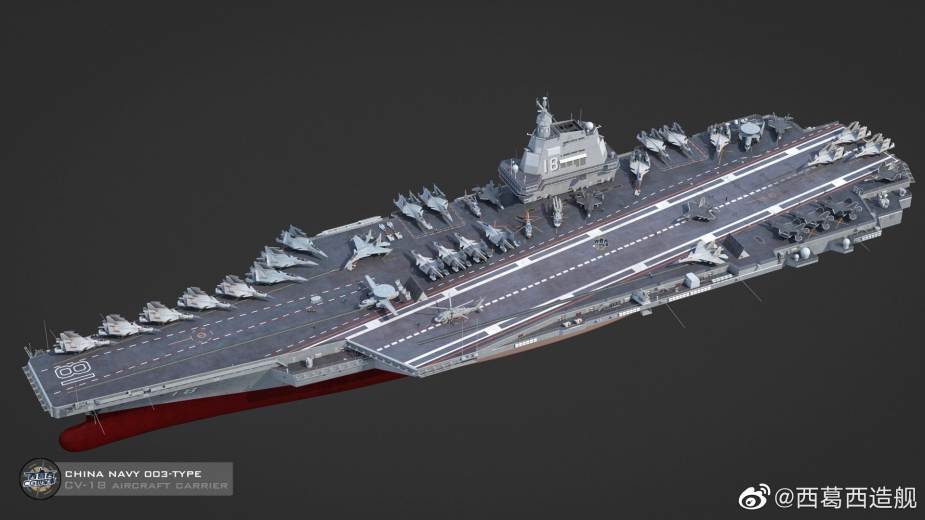On April 29, social media platforms were flooded with images purportedly showing China’s third aircraft carrier, the Fujian, embarking on what seemed to be its inaugural sea trial.
According to multiple reports, the vessel, hailed as China’s first supercarrier equipped with electromagnetic catapults, reportedly departed from its berth at Jiangnan on Changxing Island in the Yangtze River Delta.
The visuals triggered widespread speculation that the Fujian was en route to undertake its first-ever sea trials, marking a pivotal milestone in the development of the aircraft carrier.
With the assistance of several tugboats, the carrier navigated out of its berth, as shown in footage widely circulated on “X,” formerly known as Twitter.
Among the shared content, one video captured what appeared to be a fireworks ceremony preceding the anticipated sea trial, adding to the anticipation surrounding the event.
It looks like there was a fireworks ceremony before the sea trial.
source: Weibo, see watermark. pic.twitter.com/PI9UaMpJxL— Q (@foolsball) April 29, 2024
However, EurAsian Times could not verify independently whether the sea trials have begun, as subsequent images show the Fujian stationed in the Yangtze River Delta near its original berth.
Chinese Type 003 ‘Fujian’ Aircraft Carrier has started its sea trials. The 316m long super carrier is to host stealth fighter jets on it, expected to enter service in 2025. pic.twitter.com/xLI80mRFlN
— Conflict Watch PSF (@AmRaadPSF) April 29, 2024
The reasons for this halt remain unclear, and the initiation of a formal trial awaits confirmation. Earlier imagery of the Fujian had shown the carrier undergoing engine tests around April 22.
At that time, it prompted expectations that the vessel would embark on its journey around the same time as the anniversary of the Chinese Navy, on April 23.
However, despite the anticipation, the vessel remained docked, leading experts to suggest that perhaps the People’s Liberation Army Navy (PLAN) had prioritized adherence to technical schedules over symbolic gestures.
With a full displacement of over 80,000 tons, the Fujian is China’s largest warship. Launched in June 2022, it is the nation’s third aircraft carrier and the first domestically developed carrier equipped with electromagnetic catapults and arresting devices.
The utilization of catapult launch systems signifies a significant leap forward in China’s naval capabilities. These systems, more effective than ski jumps, alleviate strain during takeoff, enabling the launch of larger fixed-wing aircraft with heavier payloads and increased fuel capacity.

China’s Third Aircraft Carrier
Designed domestically, the Fujian signifies a significant leap forward in China’s efforts to bolster its armed forces. It aligns with President Xi Jinping’s vision of transforming the People’s Liberation Army (PLA) into a “world-class military” by the mid-21st century.
Experts contend that Fujian’s test runs and eventual entry into service will provide crucial insights into China’s ability to narrow the military gap with the United States, particularly amid escalating tension and Beijing’s heightened military pressure on Taiwan.
One of Fujian’s notable advancements is its capability to accommodate a comprehensive fleet of aircraft, ranging from patrol planes to early warning and control aircraft.
In mid-April, imagery emerged showing the carrier’s deck adorned with mockups of various aircraft, including the KJ-600 early warning and control aircraft, two J-15 fighters, the stealthy J-35 deck-based fighter, and a JL-10 jet trainer. The mockups represented the potential for the carrier to accommodate a variety of aircraft in its future air wing.
The inclusion of the J-35 stealth aircraft represents a major stride for the Chinese Navy, symbolizing the next generation of carrier-based fighter capability for the People’s Liberation Army Navy (PLAN).
While the Fujian remains conventionally powered and lacks the nuclear propulsion systems like US carriers, it boasts an electromagnetic catapult launch system comparable to the USS Gerald R Ford, the US Navy’s most sophisticated carrier in service.
This technological parity represents a significant departure from China’s earlier carriers, such as the Liaoning and the Shandong, which relied on older ski-jump ramps for aircraft launches.
Nonetheless, if initiated, the commencement of sea trials for the Fujian would represent the latest milestone in a development trajectory that has spanned six years since the initial sighting of a “superblock” hull module for the carrier at Jiangnan in July 2018.
The construction process, which involved assembling superblocks into larger hull segments at a specialized facility on Changxing Island, culminated in the carrier’s formal launch on June 17, 2022, amid considerable fanfare and detailed reports from Chinese state media.
As the Fujian progresses through its trial phase and eventual deployment, it is poised to redefine China’s maritime capabilities and contribute significantly to Beijing’s strategic objectives of safeguarding its interests and asserting its influence in the Indo-Pacific region.
- Contact the author at ashishmichel(at)gmail.com
- Follow EurAsian Times on Google News